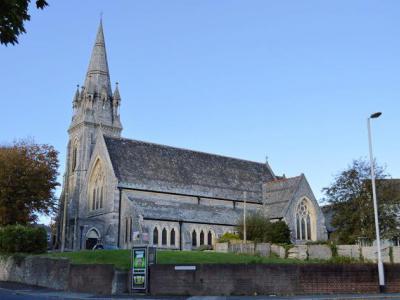St. Jude's Church, Plymouth
Saint Jude's Church in Plymouth stands as a distinguished piece of Victorian Gothic architecture, deeply woven into the city's historical and community fabric. Designed by local architect James Hine, the church was constructed between 1875 and 1876 by the Tavistock firm Blatchford and Son, with a modest budget of £3,600. Positioned prominently at the crossroads of Tothill Road and Beaumont Road, directly across from Beaumont Park, Saint Jude’s was one of several churches built under the Three Towns Church Extension Society's mission to support the city’s growing Victorian population.
Consecrated by the Bishop of Exeter, Frederick Temple, on 27 November 1876, the church initially held services in 1877, with its striking tower and spire added in 1881-82 by Mr. Philip Blowey. Constructed primarily from Plymouth limestone with Portland and Bath stone dressings, the building is a Grade II listed structure, recognized by Historic England for its early and mid-Gothic stylings. Originally, the interior was rather understated, with only the corbels at the top of the pillars carved with fruit and leaves by the famed Hems adding decorative flair.
Saint Jude’s Church became a vital place of remembrance for those lost in the world wars. The east window, damaged during the Plymouth Blitz of WWII, was replaced with a stained glass window commemorating fallen soldiers, sailors, and airmen. This addition complemented existing memorials within the church, listing 208 names of parishioners who lost their lives in both conflicts, a somber testament to the community's sacrifices.
Consecrated by the Bishop of Exeter, Frederick Temple, on 27 November 1876, the church initially held services in 1877, with its striking tower and spire added in 1881-82 by Mr. Philip Blowey. Constructed primarily from Plymouth limestone with Portland and Bath stone dressings, the building is a Grade II listed structure, recognized by Historic England for its early and mid-Gothic stylings. Originally, the interior was rather understated, with only the corbels at the top of the pillars carved with fruit and leaves by the famed Hems adding decorative flair.
Saint Jude’s Church became a vital place of remembrance for those lost in the world wars. The east window, damaged during the Plymouth Blitz of WWII, was replaced with a stained glass window commemorating fallen soldiers, sailors, and airmen. This addition complemented existing memorials within the church, listing 208 names of parishioners who lost their lives in both conflicts, a somber testament to the community's sacrifices.
Want to visit this sight? Check out these Self-Guided Walking Tours in Plymouth. Alternatively, you can download the mobile app "GPSmyCity: Walks in 1K+ Cities" from Apple App Store or Google Play Store. The app turns your mobile device to a personal tour guide and it works offline, so no data plan is needed when traveling abroad.
St. Jude's Church on Map
Sight Name: St. Jude's Church
Sight Location: Plymouth, England (See walking tours in Plymouth)
Sight Type: Religious
Sight Location: Plymouth, England (See walking tours in Plymouth)
Sight Type: Religious
Walking Tours in Plymouth, England
Create Your Own Walk in Plymouth
Creating your own self-guided walk in Plymouth is easy and fun. Choose the city attractions that you want to see and a walk route map will be created just for you. You can even set your hotel as the start point of the walk.
Plymouth Introduction Walking Tour
Plymouth's early history began in the Bronze Age when the first settlement emerged at Mount Batten. It is mentioned in Ptolemy's Geographia as a maritime outpost exporting bronze mirrors.
The settlement was a major port in the southwest of England in Roman times. It was surpassed as a port in the ninth century by the nearby wealthier village of Sutton, later called Plymouth.
... view more
Tour Duration: 1 Hour(s)
Travel Distance: 1.9 Km or 1.2 Miles
The settlement was a major port in the southwest of England in Roman times. It was surpassed as a port in the ninth century by the nearby wealthier village of Sutton, later called Plymouth.
... view more
Tour Duration: 1 Hour(s)
Travel Distance: 1.9 Km or 1.2 Miles
Pilgrim Fathers Trail
Back in the early 17th century, a group of English Puritans – nowadays reverently referred to as the Pilgrim Fathers – fled religious persecution in their homeland and established a colony in North America that later became known as Plymouth, Massachusetts. The Pilgrims embarked on their perilous journey across the Atlantic from Plymouth, England in 1620 aboard a ship called the Mayflower,... view more
Tour Duration: 1 Hour(s)
Travel Distance: 0.5 Km or 0.3 Miles
Tour Duration: 1 Hour(s)
Travel Distance: 0.5 Km or 0.3 Miles
Plymouth Hoe Walking Tour
Plymouth Hoe, referred to locally as the Hoe, is a large south-facing open public space in Plymouth with commanding views of Plymouth Sound, Drake's Island, and further afield into Cornwall. The name derives from the Anglo-Saxon word hoh, which means a sloping ridge shaped like an inverted foot and heel.
This part of town has always been a meeting place, where people would come regularly... view more
Tour Duration: 1 Hour(s)
Travel Distance: 0.7 Km or 0.4 Miles
This part of town has always been a meeting place, where people would come regularly... view more
Tour Duration: 1 Hour(s)
Travel Distance: 0.7 Km or 0.4 Miles






